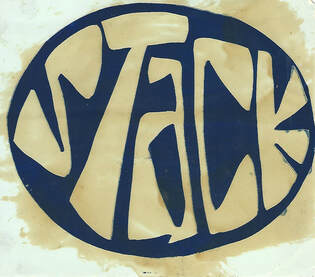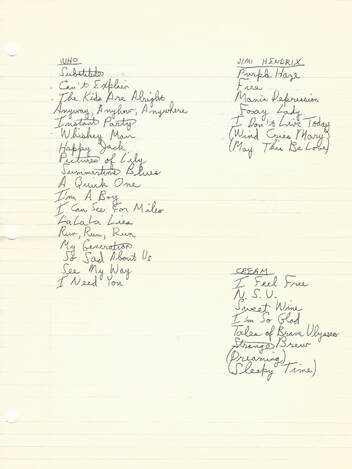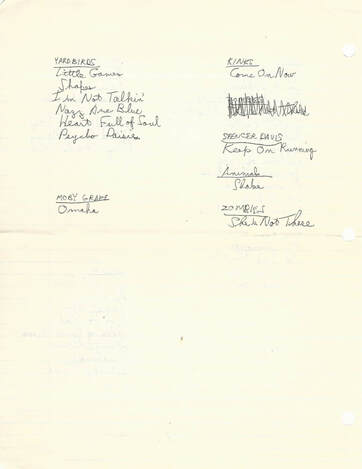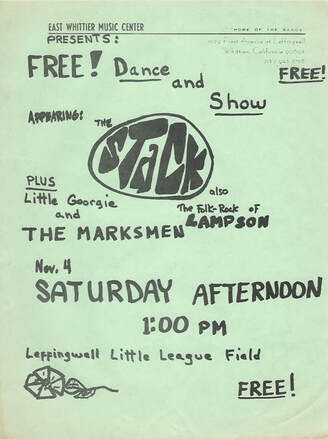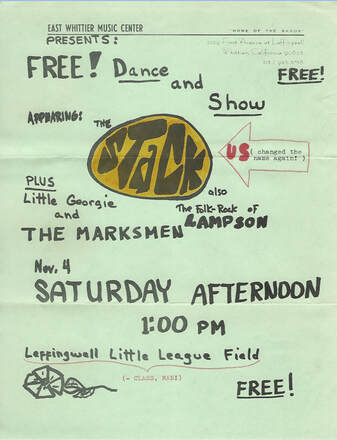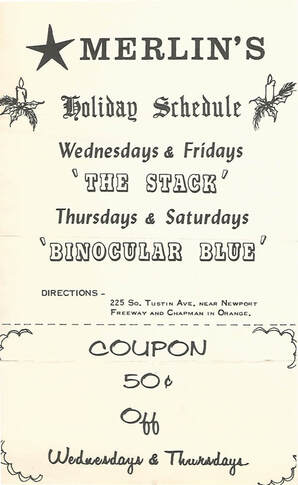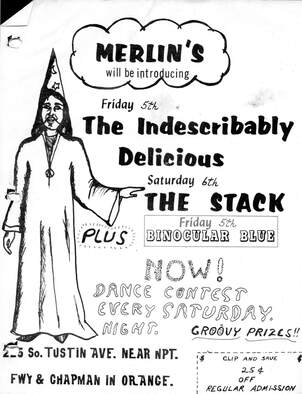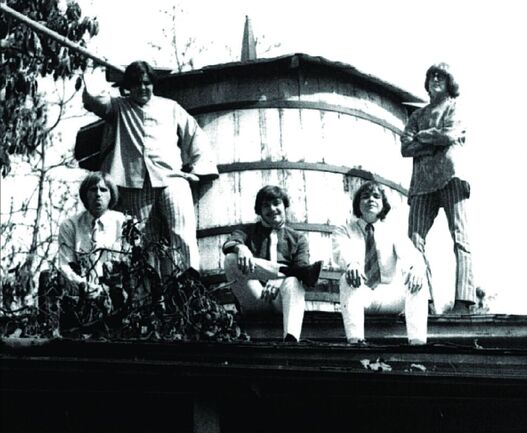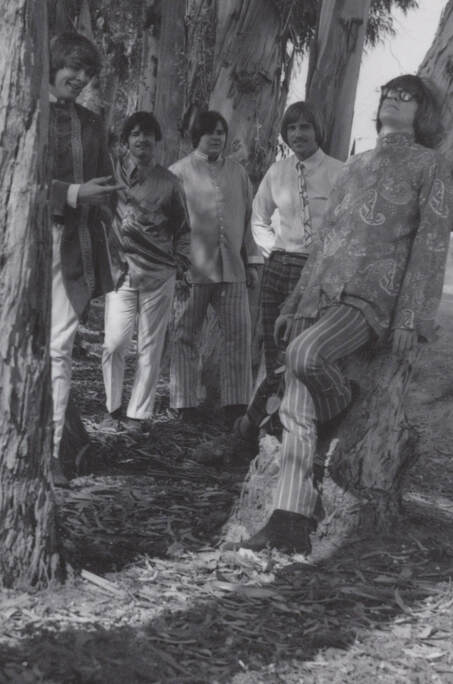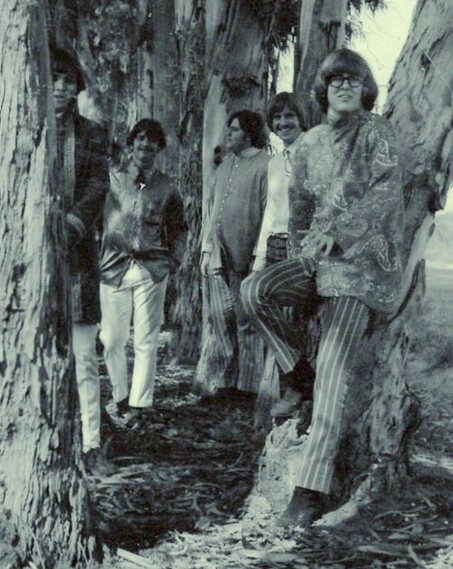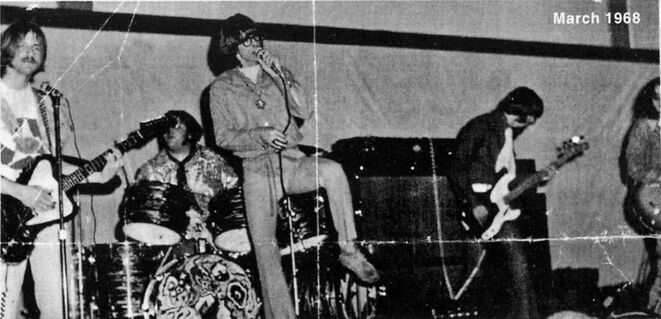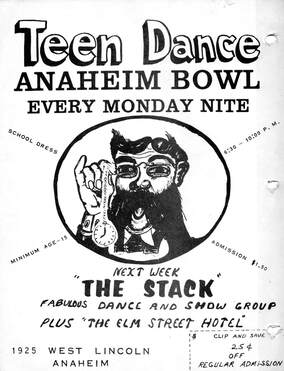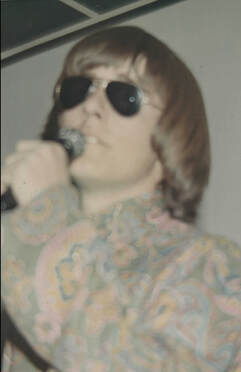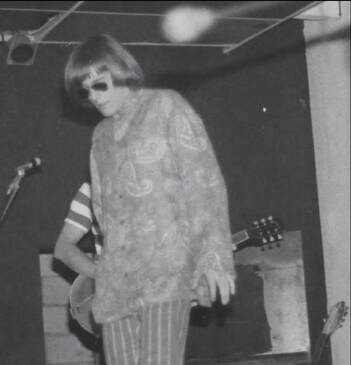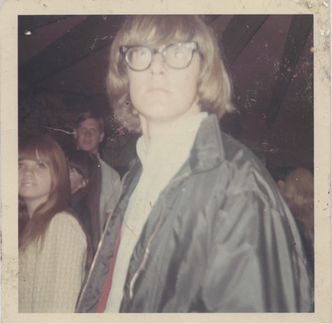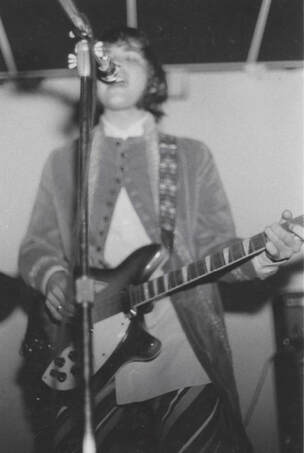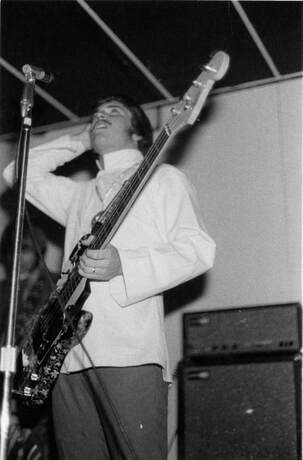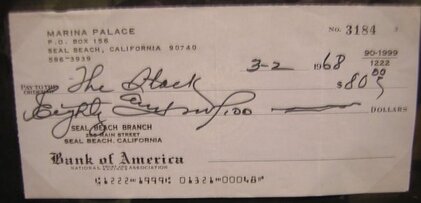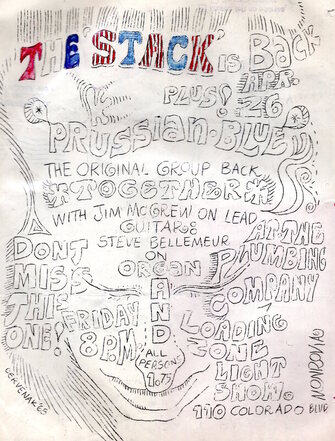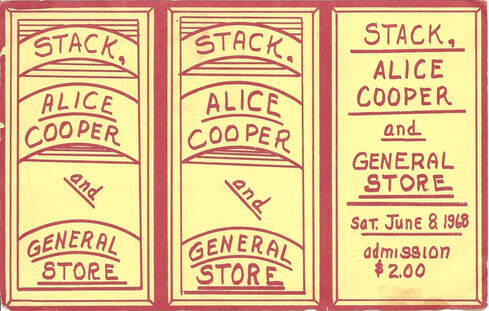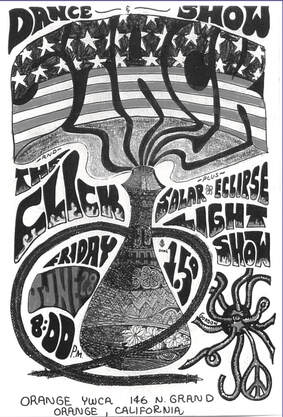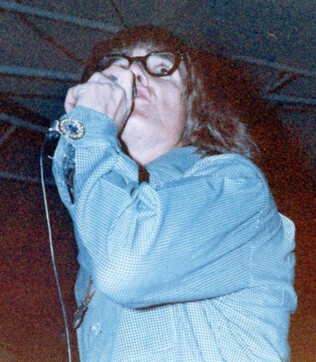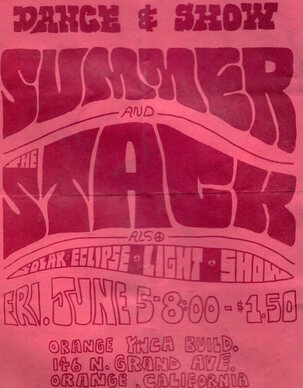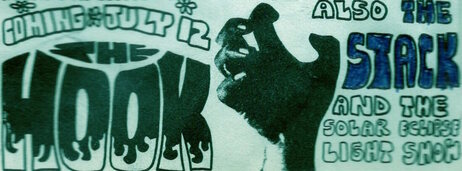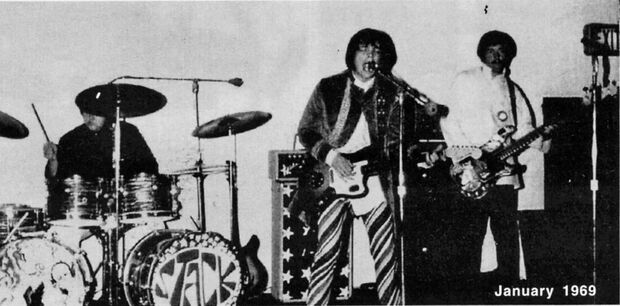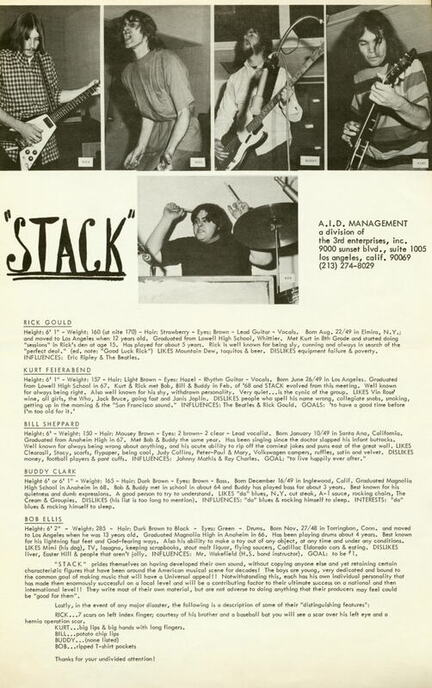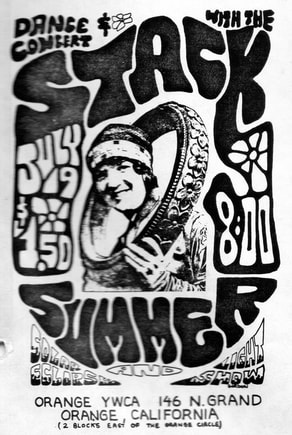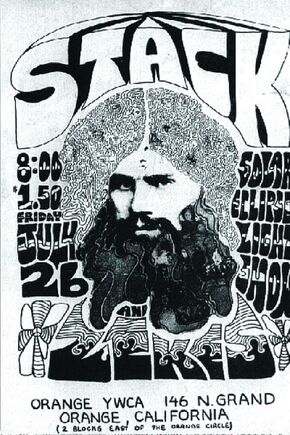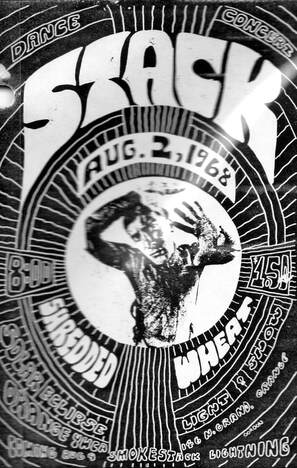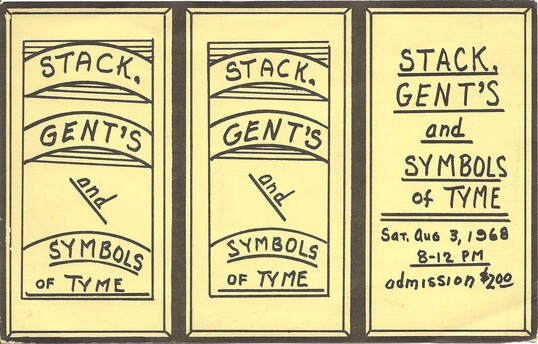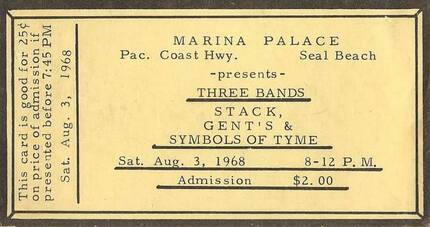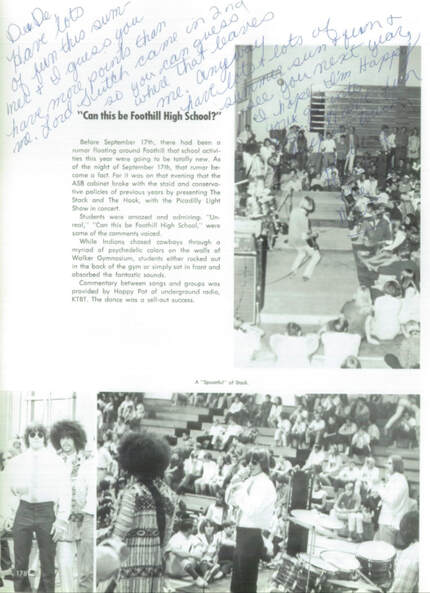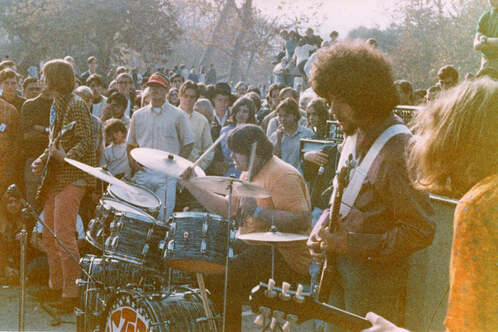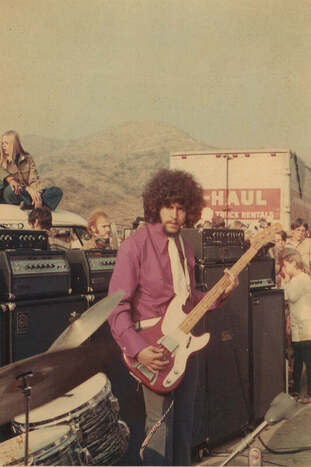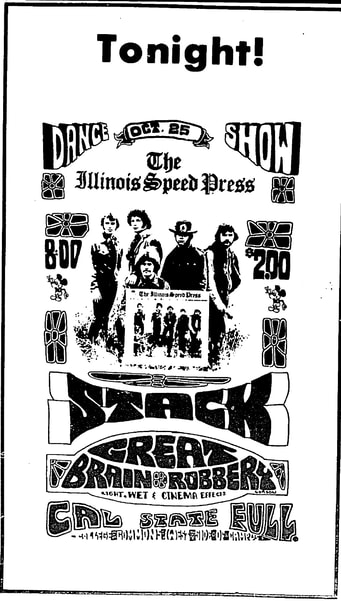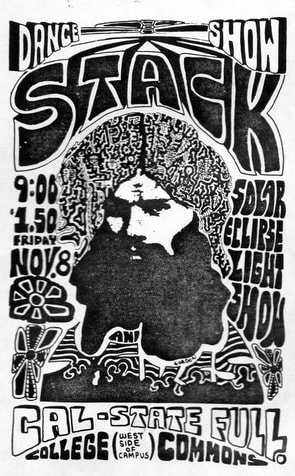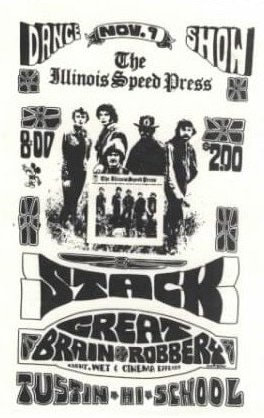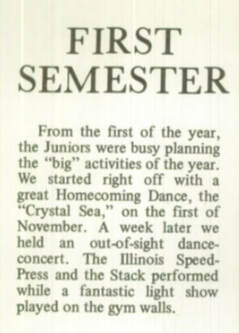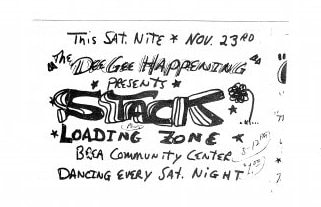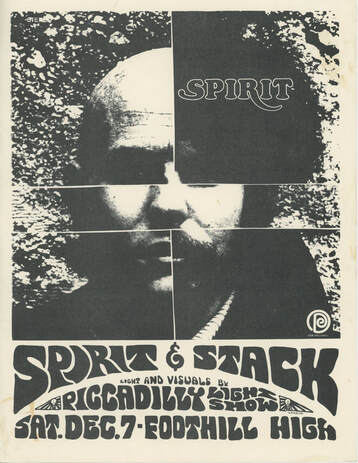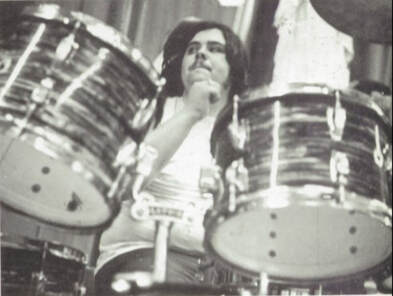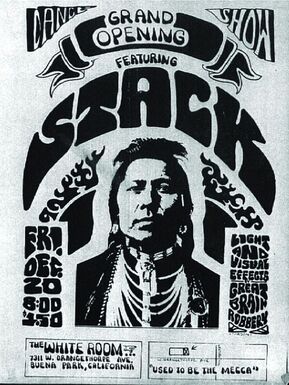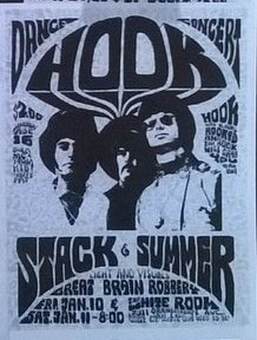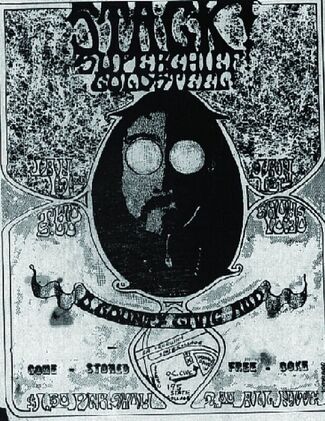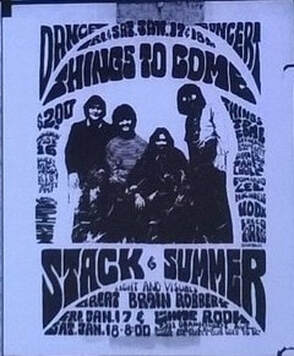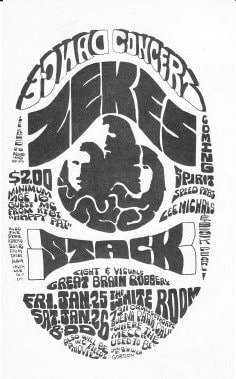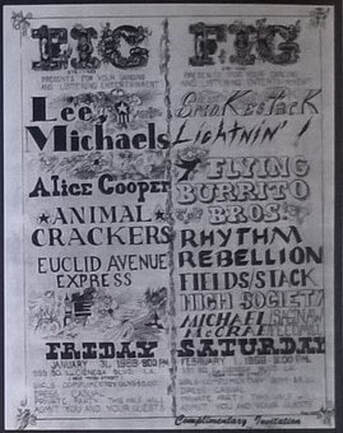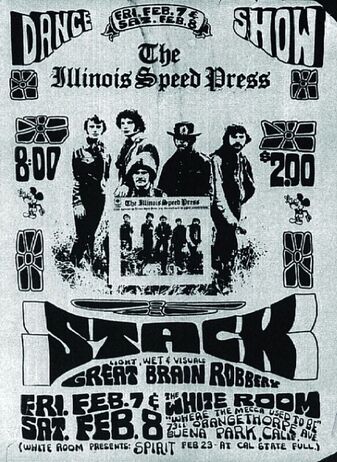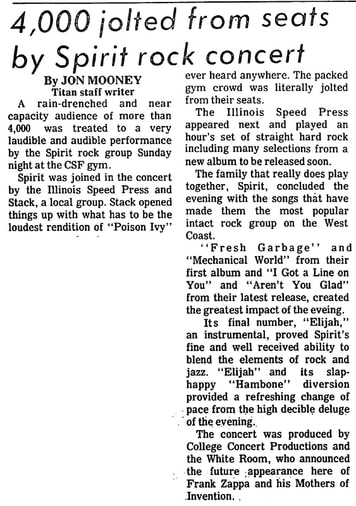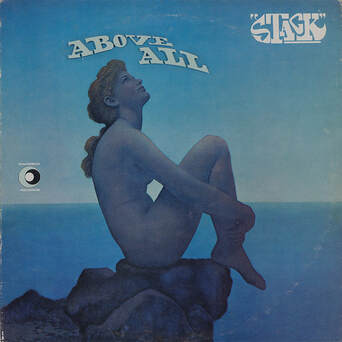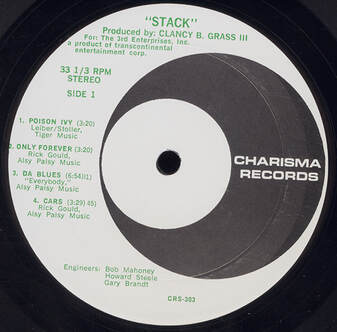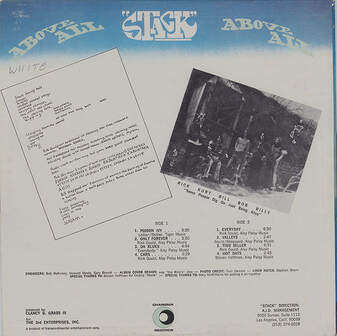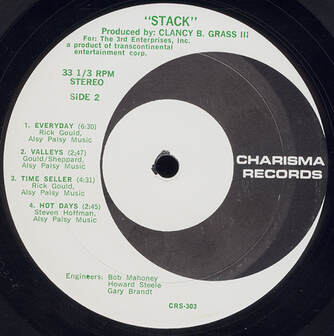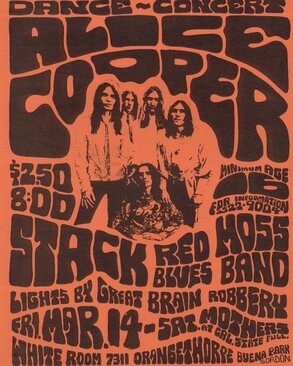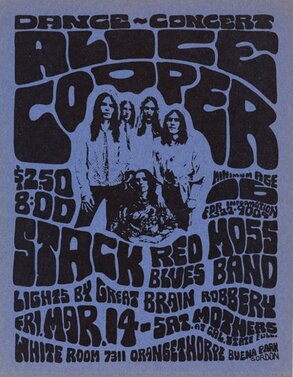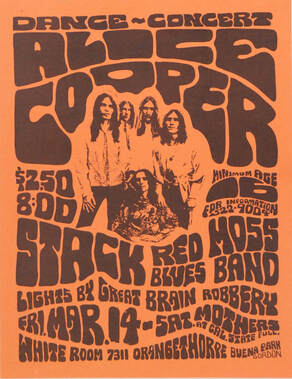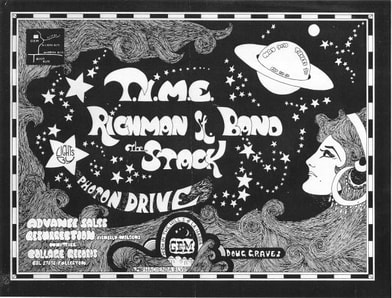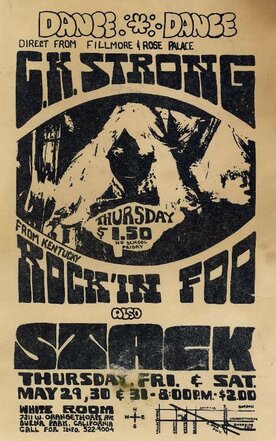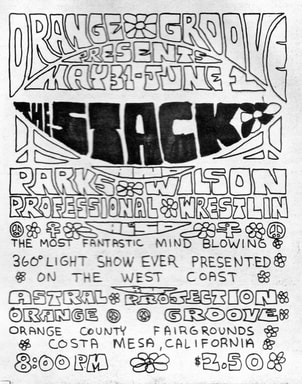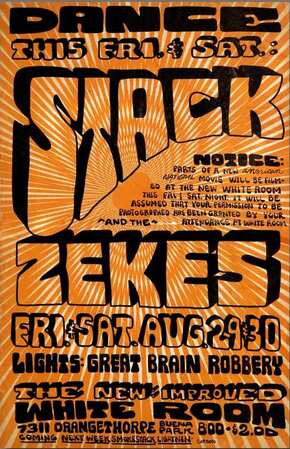If you enjoy what I have put together please consider donating any amount to support and help me to keep this valuable research going. Thanks!!
This day-by-day diary of Stack's live, studio, broadcasting, and private activities is the result of three decades of research and interview work by Bruno Ceriotti, but without the significant contributions by other kindred spirits this diary would not have been possible. So, I would like to thank all the people who, in one form or another, contributed to this timeline: Bill Sheppard, Robin Williams, Kirk Henry, Rick Gould (RIP), Kathy Hertzen, Karen Gould, Vince Basse, David Diggs, Roger Maglio, Clark Faville, Alex Carretero, Klemen Breznikar, Mike Dugo, Mike S Handley, Mike Boeck, Jerry Fuentes, Hank Fisher, Jon Mooney, Ronda Vogel, Chuck Townsend, Ron Martin, Michael Hardin, Adriana Weeda, It's Psychedelic Baby Magazine, Whittier Star Review, The Titan, The Los Angeles Times, Los Angeles Free Press, Tustin News, 1969 Tustin High School Yearbook, 1969 Sierra High School Yearbook, 1969 Foothill High School Yearbook.
January 1967 (?)
The story of Stack, one of Los Angeles' lost but legendary rock bands of the 60s, goes back to the fall of 1963 when an aspiring sax player named Rickey Elbert 'Rick' Gould (b. Monday, August 22, 1949, Elmira, Chemung County, New York), a freshman from Lowell High School in Whittier, a city in the southeast LA county, formed an instrumental surf-rock band called the Vandells. The lineup also featured a lead guitar player named James Walter 'Jim' Dole (b. Thursday, September 16, 1948, Whittier), a sophomore from local Sierra High School, plus a drummer named Skip, and two rhythm guitar players named John and Bill. After a couple of years of playing the teen dance circuit in their hometown of Whittier (Skateland) and also in Santa Ana, Orange County (YWCA Building and American Legion Hall), the Vandells disbanded in 1966. At that point, Skip, John, and Bill disappeared somewhere along with their surnames, while Rick Gould and Jim Dole decided to form a new band with a more bluesy sound inspired by the likes of Cream, The Yardbirds, The Who, and The Jimi Hendrix Experience. Also, at that point, Rick taught himself to play guitar and switched from sax to lead guitar, while Jim switched from lead guitar to lead vocals. Then, Rick's schoolmates Kurt Michael Feierabend (b. Sunday, June 26, 1949, Los Angeles) and Ronald Pierce 'Ron' Thomason (b. Monday, August 15, 1949, Los Angeles) joined on rhythm guitar and drums respectively. To complete their band, they only needed a bass player now. After auditioning at least one (and not so good) aspiring bassist, they eventually find the right one, a left-handed named Kirk Henry (b. Sunday, September 17, 1950, Salisbury, Wicomico County, Maryland). Kirk grew up in Dover, Delaware, where as a freshman he debuted playing bass in the orchestra of a high school production of Bye Bye Birdie, but at fifteen he moved with his family to Southern California, and settled in Hacienda Heights, another city in the LA county. He was a junior at the local Los Altos High School when he joined the band after “my younger brother Todd spotted an ad for a bass player on the bulletin board at Whittwood Music in late 1966 or early 1967,” recalls Henry. “I called the number and began a lifelong friendship with Rick. We went over to Kurt’s house, where someone had left a Thunderbird bass. Rick and Kurt said the owner of it was interested in joining them but he didn't pass muster, while I got the gig by dint of both chemistry and the fact that I could handle the syncopated bass on Sam Cooke's 'Shake' (the T-bird’s owner apparently couldn’t). While that song suggested a varied repertoire, we leaned heavily on Yardbirds, Who, Cream, and Hendrix material. Jim was the primary lead singer, with Kurt handling some songs. Rick and I also contributed harmonies.” The fledgling quintet, who used to practice at Rick's family home - sometimes in the living room, sometimes in the garage - called themselves The Stack. “Rick showed me business cards with the name Vandells, but the name was up for grabs, and it changed to Stack before we appeared in public,” confirms Henry. “The name Stack alluded to a Marshall stack, an image of British power that was as yet unattainable for most Americans. We were in fact playing through American amps - Rick had Gibson and Silvertone cabinets, Kurt and I used Fender amps - though we did copy the Who by replacing grill cloth with assorted flags.”
The story of Stack, one of Los Angeles' lost but legendary rock bands of the 60s, goes back to the fall of 1963 when an aspiring sax player named Rickey Elbert 'Rick' Gould (b. Monday, August 22, 1949, Elmira, Chemung County, New York), a freshman from Lowell High School in Whittier, a city in the southeast LA county, formed an instrumental surf-rock band called the Vandells. The lineup also featured a lead guitar player named James Walter 'Jim' Dole (b. Thursday, September 16, 1948, Whittier), a sophomore from local Sierra High School, plus a drummer named Skip, and two rhythm guitar players named John and Bill. After a couple of years of playing the teen dance circuit in their hometown of Whittier (Skateland) and also in Santa Ana, Orange County (YWCA Building and American Legion Hall), the Vandells disbanded in 1966. At that point, Skip, John, and Bill disappeared somewhere along with their surnames, while Rick Gould and Jim Dole decided to form a new band with a more bluesy sound inspired by the likes of Cream, The Yardbirds, The Who, and The Jimi Hendrix Experience. Also, at that point, Rick taught himself to play guitar and switched from sax to lead guitar, while Jim switched from lead guitar to lead vocals. Then, Rick's schoolmates Kurt Michael Feierabend (b. Sunday, June 26, 1949, Los Angeles) and Ronald Pierce 'Ron' Thomason (b. Monday, August 15, 1949, Los Angeles) joined on rhythm guitar and drums respectively. To complete their band, they only needed a bass player now. After auditioning at least one (and not so good) aspiring bassist, they eventually find the right one, a left-handed named Kirk Henry (b. Sunday, September 17, 1950, Salisbury, Wicomico County, Maryland). Kirk grew up in Dover, Delaware, where as a freshman he debuted playing bass in the orchestra of a high school production of Bye Bye Birdie, but at fifteen he moved with his family to Southern California, and settled in Hacienda Heights, another city in the LA county. He was a junior at the local Los Altos High School when he joined the band after “my younger brother Todd spotted an ad for a bass player on the bulletin board at Whittwood Music in late 1966 or early 1967,” recalls Henry. “I called the number and began a lifelong friendship with Rick. We went over to Kurt’s house, where someone had left a Thunderbird bass. Rick and Kurt said the owner of it was interested in joining them but he didn't pass muster, while I got the gig by dint of both chemistry and the fact that I could handle the syncopated bass on Sam Cooke's 'Shake' (the T-bird’s owner apparently couldn’t). While that song suggested a varied repertoire, we leaned heavily on Yardbirds, Who, Cream, and Hendrix material. Jim was the primary lead singer, with Kurt handling some songs. Rick and I also contributed harmonies.” The fledgling quintet, who used to practice at Rick's family home - sometimes in the living room, sometimes in the garage - called themselves The Stack. “Rick showed me business cards with the name Vandells, but the name was up for grabs, and it changed to Stack before we appeared in public,” confirms Henry. “The name Stack alluded to a Marshall stack, an image of British power that was as yet unattainable for most Americans. We were in fact playing through American amps - Rick had Gibson and Silvertone cabinets, Kurt and I used Fender amps - though we did copy the Who by replacing grill cloth with assorted flags.”
THE STACK #1 (JANUARY 1967 (?) - OCTOBER 1967)
1) Jim Dole lead vocals
2) Rick Gould lead guitar, backing vocals
3) Kurt Feierabend vocals, rhythm guitar, harmonica
4) Ron Thomason drums
5) Kirk Henry bass, backing vocals
February 1967 (?): Gymnasium (?), Lowell High School (?), 16200 East Amber Valley Drive, Whittier, Los Angeles County, California
The Stack played their debut gig at a high school whose name no one remember, although the most that make sense could be Lowell High because it was the one attended by Rick, Kurt and Ron at that time. “We opened our first gig a cappella with Cream’s 'I Feel Free',” recalls Kirk Henry. “From the first notes, the kids stopped dancing and watched open-mouthed. Since Cream, The Who, and Jimi Hendrix had yet to make a dent in the American charts, and most high school bands just copied the hits of the day, we were regarded as extremely weird, so the debut was considered a success.”
Friday, March 17 - Sunday, March 26, 1967: '6th Annual Teen-Age Fair', Hollywood Palladium, 6215 Sunset Boulevard, downtown Hollywood, Los Angeles County, California
Also on the bill: West Coast Pop Art Experimental Band, The Blues Magoos, International Submarine Band, and many others. “Since a security guard for some reason suspected that I might have lifted my still-almost-new left-handed Precision from the Fender booth, we had to make a trek over there before being cleared to perform,” recalls Kirk Henry. “Our rendition of The Yardbirds' 'I’m Not Talking' got a big response.”
Summer 1967
Some other local gigs followed in the spring of ’67 but, when the summer came, the band went on hiatus because “we just didn’t have anywhere to play,” points out Kirk Henry. “Remember, we were not professional musicians. Our social lives and potential gigs revolved around schools, and school was out, so there weren't many places to play, especially if you didn’t play what the kids were hearing on the radio and wanted to dance to.” So, with lots of free time available, Rick Gould and Kurt Feierabend headed up north to the Bay Area to attend the legendary Monterey International Pop Festival, which was held over three days from June 16 to 18. “Rick invited me to accompany him and Kurt to the festival, but I had to return to Delaware to attend my older brother's high school graduation, so I missed it because I didn’t make it back before June 16,” regrets Henry.
October 1967
In October, with the end of the summer and the prospect of returning to play new gigs that fall, the band replaced Ron Thomason with a 15-year-old prodigy drummer named Robin Bruce Williams (b. Friday, May 9, 1952, Riverside, California). “I don’t recall precisely what prompted looking for another drummer,” reminisces Kirk Henry. “Ron may not have been all that committed. I do remember that we were looking to improve, and Rick characterized Rob as ‘the best 15-year-old-drummer in Whittier’.” “I played with people that were my age before The Stack, but The Stack was my first real band,” points out Robin Williams. “I don't really remember the names of the people with I played before, but we did play at the legendary club the Troubadour when I was 14. It was an open mic night and Linda Ronstadt and The Stone Poneys played the same night.” By the way, the new lineup moved practice to Williams’ family home at that point.
THE STACK #2 (OCTOBER 1967 - EARLY FEBRUARY 1968)
1) Jim Dole
2) Rick Gould
3) Kurt Feierabend
4) Kirk Henry
5) Robin Williams drums
Saturday, November 4, 1967: Leffingwell Little League Field, Whittier, Los Angeles County, California
Robin Williams' debut gig with The Stack. Also on the bill: Little Georgie and the Marksmen, Lampson. The dance and show, which was for free and started at 1:00pm, was presented by East Whittier Music Center, a local music store where Robin worked at the time. “The owner name was Jim McInerney and he was a great guy,” recalls Williams. “He really liked the band, so my first gig with them was did behind the music store at a little league field where we made a stage. I was up on the dugout and Rick had drilled holes in the roof under my drums. When we played someone who was under me in the dugout lit smoke bombs which covered me in smoke. Unfortunately sparks rained down on my drums and destroyed the drum heads. Fortunately I got them replaced by the music store.”
Robin Williams' debut gig with The Stack. Also on the bill: Little Georgie and the Marksmen, Lampson. The dance and show, which was for free and started at 1:00pm, was presented by East Whittier Music Center, a local music store where Robin worked at the time. “The owner name was Jim McInerney and he was a great guy,” recalls Williams. “He really liked the band, so my first gig with them was did behind the music store at a little league field where we made a stage. I was up on the dugout and Rick had drilled holes in the roof under my drums. When we played someone who was under me in the dugout lit smoke bombs which covered me in smoke. Unfortunately sparks rained down on my drums and destroyed the drum heads. Fortunately I got them replaced by the music store.”
November 1967 - Early February 1968: Merlin’s, 225 South Tustin Avenue, near Newport Freeway and Chapman Avenue, Orange, Orange County, California
The Stack secured a regular weekend gig (Friday and/or Saturday, from 8:00pm to 12 midnight; also on Wednesdays during the Christmas holidays) at Merlin’s, a popular folk jazz coffee house in Orange formerly known as The Paradox, where the likes of Steve Martin, Jackson Browne (with Nitty Gritty Dirt Band), and Tim Buckley got their starts. “The place had a terrible light show,” recalled Rick Gould, “not only was the equipment bad, but the engineer was always making out with some girl on his lap while he was trying to run the lights!” “The person who did the light show at Merlin's went by ‘Reds Magic Lanterns’,” also reminisces Robin Williams. “His real name was Greg Burson who went on to become a successful voice actor who was Bugs Bunny, Yogi Bear, Mr. Magoo, and lots of others. Unfortunately Greg was a serious alcoholic and died way too young.” At the time, the venue was managed by an Italian-American guy named Mike Pinizzotto who had a sister, Shele, who was the guitar player in an all-female rock band called The Daisy Chain (which later went on to become Birtha). Needless to say, both bands shared the bill at Merlin’s sometimes, so they became really good friends.
November 1967 - Early February 1968: Merlin’s, 225 South Tustin Avenue, near Newport Freeway and Chapman Avenue, Orange, Orange County, California
The Stack secured a regular weekend gig (Friday and/or Saturday, from 8:00pm to 12 midnight; also on Wednesdays during the Christmas holidays) at Merlin’s, a popular folk jazz coffee house in Orange formerly known as The Paradox, where the likes of Steve Martin, Jackson Browne (with Nitty Gritty Dirt Band), and Tim Buckley got their starts. “The place had a terrible light show,” recalled Rick Gould, “not only was the equipment bad, but the engineer was always making out with some girl on his lap while he was trying to run the lights!” “The person who did the light show at Merlin's went by ‘Reds Magic Lanterns’,” also reminisces Robin Williams. “His real name was Greg Burson who went on to become a successful voice actor who was Bugs Bunny, Yogi Bear, Mr. Magoo, and lots of others. Unfortunately Greg was a serious alcoholic and died way too young.” At the time, the venue was managed by an Italian-American guy named Mike Pinizzotto who had a sister, Shele, who was the guitar player in an all-female rock band called The Daisy Chain (which later went on to become Birtha). Needless to say, both bands shared the bill at Merlin’s sometimes, so they became really good friends.
Late 1967 or Early 1968: Gymnasium, Lowell High School, 16200 East Amber Valley Drive, Whittier, Los Angeles County, California
Saturday, January 6, 1968 (could be April 6, 1968): Merlin’s, 225 South Tustin Avenue, near Newport Freeway and Chapman Avenue, Orange, Orange County, California
Saturday, January 20, 1968: Whittier High School Auditorium, corner of Whittier Avenue and Bailey Street, Whittier, Los Angeles County, California
Stack opened unbilled for Buffalo Springfield. Also on the bill: The Hard Candy, Bob Wahler. The show, which started at 8:30pm, was presented by Canfield. “When we did the concert with Buffalo Springfield we were added after the poster was printed,” recalls Robin Williams, “and the concert was created by Bob Wahler’s manager to boost his career and I have no idea what ever happened to him.” “We had some great gigs at the time, one of which was opening for Buffalo Springfield - they were incredible!,” exclaimed Rick Gould. “I can still recall some girls talking to me outside the stage door and when they saw Kurt with his big mutton-chop sideburns, they shouted 'Are you Neil Young?' When Kurt responded 'Nope', they said 'Well, then get out of the fuckin way!'.” By the way, apparently a tape of the show exist.
Monday, January 22, 1968: Merlin’s, 225 South Tustin Avenue, near Newport Freeway and Chapman Avenue, Orange, Orange County, California
“We played at Merlin's on a Monday night after the concert with Buffalo Springfield,” recalls Robin Williams.
Monday, January 29, 1968 (?): 'Teen Dance', Anaheim Bowl, 1925 West Lincoln Avenue, Anaheim, Orange County, California
One show, from 6:30pm to 10:00pm. The Stack were booked to play a Monday night teen dance at the Anaheim Bowl, a bowling alley. The gig was secured by Mike Pinizzotto who managed that venue too. Sharing the stage with them that day was another local band called Wabash Spencer Band (formerly known as The Fabs). “The night Stack opened for Wabash Spencer we heard them for the first time and were impressed with Rick Gould’s guitar playing and Kurt Feierabend's vocals and stage presence,” recalls Wabash’s singer Bill Sheppard. The show was such a blast, and both bands played so well, that a few days later “Mike came up with the idea to combine selected players from each group and approached who he thought would be the most impressive together as a supergroup,” adds Sheppard. “Mike was either (a) a visionary who knew talent when he saw it, (b) a hanger-on trying to insinuate himself into the bands of his sister and friends, or (c) a combination of the two,” reflects Kirk Henry. Anyway, the players chosen by Pinizzotto to form the so-called ‘supergroup’ were lead singer William David 'Bill' Sheppard (b. Monday, January 10, 1949, Santa Ana, California) and drummer Robert 'Bob' Ellis (b. Saturday, November 27, 1948, Torrington, Connecticut) from Wabash Spencer Band, which at that point disbanded, and Rick Gould and Kurt Feierabend from The Stack, which at that point disbanded too. “By then, Jim Dole had a full-time job and I was committed to attending UCLA that fall, so it was understood that I [and Jim] would leave the band,” points out Kirk Henry. “Rick and Kurt graduated high school in 1967, so in 1968 they were grappling with what to do with the rest of their lives. They had to make some moves, they needed other players to keep going if they were serious about pursuing careers in rock. Rick told me they had decided to break up the band and start anew, which is exactly what they did.”
February ?, 1968: Merlin’s, 225 South Tustin Avenue, near Newport Freeway and Chapman Avenue, Orange, Orange County, California
So, while Jim Dole and Kirk Henry left the band as mutually agreed after a last weeknight gig at Merlin’s in early February, the poor teenage drummer Robin Williams was instead fired by Mike Pinizzotto that same night. “After the gig he took me out to Jack In The Box for a hamburger and gave me the news. I didn't eat hamburgers for a long time,” bitterly recalls Williams. “Mike was creating a new band and I was the only one who was told about the change. I knew it wasn't personal, but it was time, I was too young, but I was devasted.” “Mike taking it upon himself to (as he phrased it) 'fire' Robin was Mike trying to make himself feel important, since he was trying to play manager despite having neither experience nor skill,” reflects Henry. “After Stack I went on to play in lots of groups, Autumn People, French Lick, and a band called Seegull which almost made it but you know the story,” adds Williams. “Anyway I never left the music industry. Working for companies like G&L guitars, Kawai keyboards, and Samick guitars. And I have worked with everyone from Jackson Browne to Ian Mclagan who became a close friend and incidentally was married to Keith Moon's ex wife Kim. I managed the Plant Studios in Sausalito where Rumors was recorded. I was the last manager before the studio closed.”
February 1968
By February, and after the addition of Rick and Kurt’s former Lowell High schoolmate Chuck Berry (b. 1948) on bass (although he was actually a guitarist), the new quintet started rehearsing together at Merlin’s because “it was located in a strip mall and noise wouldn’t be an issue,” points out Bill Sheppard. They also decided to called themselves… well… Stack (now without the definite article). “Mike liked the name and so did the rest of us so it stuck,” confirms Sheppard. “In the beginning we played a mix of Bee Gees, Beatles, Yardbirds, Who, Cream, etc. We began to gravitate toward signature songs for each vocalist. Kurt did 'Stone Free' by Hendrix, 'Sitting on Top of the World' by Cream, 'Magical Mystery Tour' by The Beatles, that kind of stuff. I did 'Hurdy Gurdy Man' by Donovan, 'And the Sun Will Shine' by The Bee Gees, 'Substitute' by The Who, and that kind of stuff. All three of us (Rick, Kurt, and myself) had real strong voices. There was no such thing as monitor speakers at the time and so a vocalist had to sing loud enough to be heard (and to hear themselves) over a heavy hitting drummer, booming bass, and a couple of Marshall stacks. Ah, the good old days! Huh?”
STACK #1 (FEBRUARY 1968 - JULY 1968)
1) Rick Gould
2) Kurt Feierabend
3) Bob Ellis drums
4) Bill Sheppard lead vocals, tenor sax
5) Chuck Berry bass
1) Rick Gould
2) Kurt Feierabend
3) Bob Ellis drums
4) Bill Sheppard lead vocals, tenor sax
5) Chuck Berry bass
February 1968: Gymnasium, Los Altos High School, 15325 Los Robles Avenue, Hacienda Heights, Los Angeles County, California (cancelled)
The gig was cancelled at last minute because it was booked by the "original" Stack who in the meantime had disbanded. “When Stack splintered, Rob and I were both mainly disappointed that we didn’t get to play the gig I had just booked at Los Altos High School (my school), because we had never played there, and we were going to be paid $200,” points out Kirk Henry.
Monday, unknown date, 1968: 'Teen Dance', Anaheim Bowl, 1925 West Lincoln Avenue, Anaheim, Orange County, California
Also on the bill: The Elm Street Hotel. One show, from 6:30pm to 10:00pm.
February - April or May 1968: Merlin’s, 225 South Tustin Avenue, near Newport Freeway and Chapman Avenue, Orange, Orange County, California
The "new" Stack continued to play their regular weekend gig (Friday and/or Saturday, from 8:00pm to 12 midnight) at Merlin’s, at least because Mike Pinizzotto became their manager at that point.
Saturday, March 2, 1968: Marina Palace, Northeast corner of Pacific Coast Highway and First Street, Seal Beach, Orange County, California
Friday, April ?, 1968: The Plumbing Company, 110 East Colorado Boulevard, Monrovia, Los Angeles County, California
“The Plumbing had a rotating schedule of bands that booked about 2 months in advance and we were part of that schedule,” recalls Bill Sheppard. “Bill Willtrout (the club manager) was also involved with the early marketing of Ovation guitars and was instrumental in our endorsement proposal with Ovation (we turned them down because we wanted Fender or Gibson). At the same time we were offered an endorsement deal by Rickenbacker for their guitar amps and cabinets (strange trapezoidal cabs with blue and green plaid grill cloths, we turned them down too, wanted their guitars and basses). We toured the facility with Bob Seeger’s band.”
Friday, April 19, 1968: Purple Haze, corner of Tyler Street and Magnolia Avenue, Riverside, California
Also on the bill: Lollipop Shoppe, Hunger.
Friday, April 26, 1968: The Plumbing Company, 110 East Colorado Boulevard, Monrovia, Los Angeles County, California
Also on the bill: Prussian Blue. Lights by Loading Zone Light Show. One show, started at 8:00pm. It was before a Friday night gig at The Plumbing Company in April or May ’68, that the band decided to fired Mike Pinizzotto. “I remember being at the Plumbing and having a business meeting before our show about getting rid of Mike,” confirms Bill Sheppard. “We spent the first months playing small nightclubs and playing cover material until we began to develop our own sound. In doing so, we began to grow weary of what we considered no progress and decided to drop Mike as our manager. He also still had the girls group Birtha under contract so he was otherwise occupied.”
April or May 1968
With Mike Pinizzotto out of the picture, “we had been approached by Marina Palace’s owner, a gentleman by name of Bill Robertson, about managing us, although we never had a formal signed agreement with him,” recalls Bill Sheppard. Needless to say, at that point the band moved practice from Merlin’s (which, by the way, closed for good shortly after in May) to Marina Palace. “Bill was a professional and expected the same out of our band,” points out Bill Sheppard. “We had a set schedule from 10 am to 5 pm daily Monday thru Friday. He’d meet us at ‘the palace’ open the coke machine, put two hot dogs each on the grill, and lock us in to rehearse. It was a huge isolated quonset building that could handle audiences of 1000 or more and had a mirrored lobby in the women’s restroom. He had us rehearse together in there facing the mirrored wall so that we could see what we looked like to an audience when we were performing (very effective). Rick also began to write some of the material for our album Above All during that period.”
Thursday, May 30, 1968: Purple Haze, corner of Tyler Street and Magnolia Avenue, Riverside, California
Stack were booked to play as opening act for one of their idols, The Yardbirds, at the Purple Haze in Riverside. “After the gig our bass player Chuck Berry ended up in a scuffle in the parking lot with one of the Yardbirds’ roadies who’d pulled a knife on him,” reminisces Bill Sheppard, “but Chuck quickly grabbed the boom arm of a mic stand and swung it helicopter style until the guy calmed down and was shuffled off by his friends.”
Saturday, June 8, 1968: Marina Palace, Northeast corner of Pacific Coast Highway and First Street, Seal Beach, Orange County, California
Also on the bill: Alice Cooper, General Store. “One band that actually opened for Stack [there] was Alice Cooper,” recalled Rick Gould. “I remember numerous times we sat in the dressing room with Alice and he went on first, letting us finish the bottle of Pagan Pink Ripple.”
Friday, June 28, 1968: 'Dance Show', Orange YWCA, 146 N Grand Street, Orange, Orange County, California
Also on the bill: The Click. Lights by Solar Eclipse Light Show. One show, started at 8:00pm. “Stack was becoming quite popular and on any given Friday night we would draw between 1000-1500 kids there to hear us,” recalls Bill Sheppard. “Years later I was watching this Tom Hanks directed movie - That Thing You Do! and I recognized the venue from the stage looking out toward the audience - it was filmed at the Orange YWCA! It was eerie remembering a building from that vantage point, knowing the room that well. It brought back memories of the screaming, wild audiences that showed up there for Stack.”
Friday, July 5, 1968: 'Dance & Show', Orange YWCA, 146 N Grand Street, Orange, Orange County, California
Also on the bill: Summer. Lights by Solar Eclipse Light Show. One show, started at 8:00pm.
Friday, July 12, 1968: Orange YWCA, 146 N Grand Street, Orange, Orange County, California
Also on the bill: The Hook. Lights by Solar Eclipse Light Show. One show, started at 8:00pm.
July 1968
In July, in the midst of a summer full of commitments, Stack found the time to fire Chuck Berry and to replace him with a better bass player named Dale Alan ‘Buddy’ Clark (b. Friday, December 16, 1949, Inglewood, California). Buddy was a long time friend of Bob Ellis since high school and they had played together, with Bill Sheppard too, in The Fabs, and Wabash Spencer Band. “Chuck was chosen by Rick and Kurt, and I’m not sure why Buddy wasn’t chosen initially for the supergroup,” reflects Sheppard. “Chuck, although a great guy and a talented guitarist, hadn’t really spent as much time with the bass, and the rest of the band had been noticing that he wasn’t the level of bass player that Rick and Kurt had hoped he would grow into. When the discussion finally had reached the ‘shit or get off the pot’ level, Bob and I suggested Buddy as we’d had faith in his abilities from the start.” Curiously, instead of his old friends Rick and Kurt as you could expected, it was his new and embarassed friend Bill who give to Chuck the bad news. “I had to tell him of the band’s decision,” confirms Sheppard. “It was outside Marina Palace in the loading area. Kurt stayed off to the back of our huddled little group playing harmonica and staring at the pavement, Rick was silent too... Chuck pulled up, his red and white striped American flag covered grill cloth in the back seat of his convertible, parked and started to get out and I stopped him cold, ‘Chuck, don’t unload your stuff, we’ve decided to make a change at bass going forward. We love you man, but it’s just not working out. Sorry.’ It got really quiet and Chuck kind of shrugged, jumped in his car and drove away. Nothing more was said. I’ve always felt bad about having to be the axeman, but it had to be done. About an hour later Buddy pulled up in his Volvo ‘derby’ and we had our first rehearsal.” “This final lineup of Stack was very successful in southern California. We were like one very big happy family of kids. My girlfriend was even Buddy’s twin sister Kathy,” recalled Rick Gould.
STACK #2 (JULY 1968 - JULY 1969 (?))
1) Rick Gould
2) Kurt Feierabend
3) Bob Ellis
4) Bill Sheppard
5) Buddy Clark bass, vocals, baritone sax
Friday, July 19, 1968: 'Dance Concert', Orange YWCA, 146 N Grand Street, Orange, Orange County, California
Also on the bill: Summer. Lights by Solar Eclipse Light Show. One show, started at 8:00pm.
Friday, July 26, 1968: 'Dance Concert', Orange YWCA, 146 N Grand Street, Orange, Orange County, California
Also on the bill: Zekes. Lights by Solar Eclipse Light Show. One show, started at 8:00pm.
Friday, August 2, 1968: 'Dance Concert', Orange YWCA, 146 N Grand Street, Orange, Orange County, California
Also on the bill: Shredded Wheat. Lights by Solar Eclipse Light Show. One show, started at 8:00pm.
Saturday, August 3, 1968: Marina Palace, Northeast corner of Pacific Coast Highway and First Street, Seal Beach, Orange County, California
Also on the bill: Gent's, Symbols Of Time. One show, from 8:00pm to 12 midnight. After the show, the band driving over to the Orange Country Fairgrounds in Costa Mesa, “for the after the show parties at the Newport Pop Festival,” recalls Bill Sheppard. “As with many events in those days, hippy events that is, people brought tents, and sleeping bags. There was a large open field next to the fenced in fairgrounds and there were many hundreds if not thousands of people in makeshift campsites gathered and just hanging out together.” “All the Stack boys were there and we drank and cavorted with the horde,” he continues. “However, we were pissed because we’d born doing shows with a bunch of the groups who played the festival (Alice Cooper for example), but were overlooked because we didn’t have a record out yet.”
Friday, August 9, 1968: The Plumbing Company, 110 East Colorado Boulevard, Monrovia, Los Angeles County, California
Wednesday, August 28, 1968
Stack driving over to Santa Monica Civic Auditorium that night, to watching a show of one of their idols, The Who. “Our road manager, Joe Taylor, who had previously been The Who’s road manager, got us press passes so we sat just beyond the orchestra pit,” reminisces Bill Sheppard. “Keith Moon was great, while Roger Daltrey got pissed and threw his mic at a roadie onstage!” “However, Joe was a flash in the pan with us,” also reflects Sheppard. “He accomplished two major things during his brief tenure: 1) he acquired us press seats for The Who show, and 2) he got us a partial endorsement with Sunn amplification which on a few occasions furnished us with our whole backline amps and speaker cabs (stenciled with The Who) as it was part of Sunn’s promo stock and was used by Pete Townshend and John Entwistle while they were in the States.”
Friday, August 30, 1968: Swing Auditorium, National Orange Show Grounds, 689 South East Street, San Bernardino, California
Stack opened unbilled for Iron Butterfly. Also on the bill: Caretakers, The End. One show, started at 8:00pm. “We’d had a little trouble backstage as Erik Brann the guitarist from IB was being a whiney baby about our roadies grabbing one of their cases of beer for our dressing room but we then lined up behind the curtain waiting anxiously to open the show,” reminisces Bill Sheppard. “We opened with our version of ‘Poison Ivy.’ Rick’s big explosive power chords, Bob’s pounding, thumping double kick drums, Buddy’s deep rumbling bass, and our always strong vocals and harmony. There were 8-9k people in the audience, and they jumped from their seats and rushed the stage trying to touch us, get close to us (almost creamed my jeans). Security immediately lined up guards at the edge of the stage accompanied by some local police, it was exhilarating, almost sexual! At that moment my sense of power was incredible, the whole building was electrified! A stage rush!! How cool is that?” “After the show I remember having breakfast at Denny’s in San Bernardino,” continues Sheppard. “We were all elated and manic. Buddy, having just quit working at Knott’s Berry Farm, was wearing an afro wig because his hair was still short from his straight gig, and we were a bit drunk and wound up. We ordered sandwiches and, in that era and at this particular restaurant, sandwiches were served with toothpicks with brightly colored cellophane ‘guides’ on them mimicking the feather guides on an arrow skewering the halves together so as not to allow them to separate before serving. At some point, Buddy turned his head to the right and one of us giddy fools tossed an orange colored toothpick into his wig. It stuck but because it was separated from his scalp Buddy didn't feel it. It triggered a covert game of getting Buddy’s attention on one side and a sly toss from the other making sure not to bring his attention to it. Slowly the red blue, yellow, orange, and green guides were populating the wig, and each addition becoming more and more hilarious. After 30 minutes or so, he looked like a Christmas tree! We just sat and laughed and I don't think he realized they were there until he got home hours later.”
Saturday, September ?, 1968: Marina Palace, Northeast corner of Pacific Coast Highway and First Street, Seal Beach, Orange County, California
After one of their usual Saturday night gig at Marina Palace, the band was approached backstage by Steve Hoffman, a Los Angeles singer, songwriter, and multi-instrumentalist who at the time was the leader of a psychedelic band called the Mystic Astrologic Crystal Band. “Yes, Steve saw the band at Marina Palace and told us that he had some influential people who might be interested in working up a record deal for the band,” recalls Bill Sheppard. “Buddy was now a member and we were under full steam with adding our original material. Up to his joining the group there was only ‘cover’ material so I guess he inspired us in that direction.” Anyway, one of those influential people Steve was talking about was his producer Clancy B. Grass III, who eventually signed the band for his own company, The 3rd Enterprises Inc., which was one of the many connected divisions under the umbrella of a major New York-based distribution music company called Transcontinental Entertaintment Corporation. “Mike Curb, who ten years later served as Lieutenant Governor of California, was the head music person for Transcontinental at the time,” adds Sheppard, “but I don’t believe any Stack member ever met him personally. I don’t remember if Clancy ever saw the band live and I’m sure Mike never did, it was all done with Steve’s recommendation.” “Before we knew it, we were having our parents co-sign contracts for us on an eight year deal, which we regret to this day,” also recalled Rick Gould. “It was such a one-sided contract: they got everything, we got nothing. No equipment, no money, nothing!” “Rick was absolutely correct in the length of the contract,” contiues Sheppard. “Much like Creedence Clearwater Revival, we became unwitting slaves to management for 8 years. It was overseen by a superior court hearing because we were all minors (under 21), so our parents had to attend the hearing and approve the contract.” With a record deal in the pocket, Stack were now a professional band so they said “goodbye” to Bill Robertson and then signed a formal management contract with a Hollywood company called A.I.D. Management. “The only thing I remember about them,” recalls Sheppard, “was that they gifted Rick with a new 100-watt Marshall stack along with a new Gibson Flying V guitar in late ’68 or early ’69. They purchased it from Wallichs Music City on Sunset and Vine.” At that point, of course, they also became persona non grata at Marina Palace. “After we signed with Clancy we were no longer under Bill’s guidance and not able to use that facility,” confirms Sheppard, “so sometimes we’d have nighttime ‘quiet’ rehearsals at my parents’ house in Anaheim, and other times we’d have afternoon ‘loud’ rehearsals at Kurt’s parents’ garage in Whittier.”
Friday, September 13, 1968: Walker Gymnasium, Foothill High School, 19215 Dodge Avenue, Santa Ana (mailing address, but the school is actually in North Tustin), Orange County, California
Also on the bill: The Hook, KTBT disc jockey Happy Pat (MC). Lights by Picadilly Light Show. The show was sponsored by the school's Associated Student Body (ASB).
October 1968 (?): 'KTBT Kite Flying Contest', Irvine Park, 1 Irvine Park Road, Orange, Orange County, California
Stack were among the several local bands who played at a free outdoor show sponsored by KTBT (94.3 FM), an underground radio station located in Garden Grove, Orange County. “It was like a 'love-in',” recalls Bill Sheppard. “A few thousand people. Stack was a favorite of KTBT dj Jim Foss, aka Gentle Dental.” “There were a few 'love-ins' held in Irvin Park [at the time]," also recalls the band's die hard fan Mike Boeck. “Then 'the man' realized how subservise hippies were and we were no longer allowed there. 'Subversive' meaning we actually protested being forced to go to Vietnam to shoot human beings and be shot back at, all for nothing.”
Friday, October 25, 1968: 'Dance Show', College Commons, west side of California State University campus, 800 North State College Boulevard, Fullerton, Orange County, California (Stack cancelled)
Also on the bill: The Illinois Speed Press. Lights by Great Brain Robbery. One show, started at 8:00pm.
Friday, October 25, 1968: '11th Annual Grecian Homecoming Dance', Gymnasium, Sierra High School, 9401 South Painter Avenue, Whittier, Los Angeles County, California
October or November 1968 (?)
Rick Gould was hired to backing up the famous rhythm ‘n’ blues vocal group Archie Bell & The Drells, who had recently reached the number one spot on the Billboard’s single charts with their funky song ‘Tighten Up.’ “Apparently, that was a studio record and there was no real group, so they picked up-and-coming players, paid them scale, and charged concert level money for the performances,” recalls Bill Sheppard. “Rick played live with Archie Bell for only one live date that I was aware of.”
Late October - Early November 1968 (?): Sunwest Recording Studios Inc., 5539 Sunset Boulevard, Hollywood, Los Angeles County, California
That fall of ’68, between their aforementioned live commitments, Stack finally put together enough original material to record an album. So, approximately around late October and early November 1968, they headed into Sunwest Recording Studios Inc. in Hollywood and, whitin 3 or 4 sessions, lay down eight songs. First of all, a cover of Leiber & Stoller’s ‘Poison Ivy’ (originally recorded by The Coasters in 1959), which was a sure choice because it was their “workhorse”, the song with whom they opened every single show since the “classic” lineup get together (and in fact it was also chosen as the opening track of the album). Then, an original penned by Steve Hoffman and titled ‘Hot Days.’ “Steve’s valuable interest in Stack was one of the considerations for the selection of his song for the album,” points out Bill Sheppard. “He auditioned Kurt and me for the vocal lead and I was awarded the part on the recording.” Later, another original penned by Kurt Feierabend and titled ‘Do It,’ which eventually wasn’t included in the album for unknown reasons. “He asked me to do the vocal on it and I did and liked the recording. I thought it should have been released on the album (sorry Kurt),” regrets Sheppard. “However, the subsequent re-released versions of the album included it.” Lastly, the band recorded five songs all penned by Rick Gould: ‘Only Forever,’ (“where I remember doing the lead vocal really high on a joint of Acapulco Gold and that pissed Rick off,” reminisces Bill Sheppard. “He was a heavy drinkier but not fond of ‘potheads’”), ‘Everyday,’ ‘Time Seller’, ‘Cars’, and ‘Valleys’, the latter co-written by Sheppard. “On one particular session I suggested the melody line for ‘Valleys’ as Rick’s idea was to follow the guitar riff,” he recalls. “I thought it was better to let the riff carry under the half time vocal line, the guys agreed and it stuck.” “By the way, I also co-wrote ‘Cars’ but I didn’t get credit for it on the writer’s contracts and on the album (thanks Rick),” he also bitterly points out.
Early November 1968 (?): Producer's Workshop, 6035 Sunset Boulevard, Hollywood, Los Angeles County, California
Actually, the band had at least another song to record for the album, an original penned by all the five members of the band and titled ‘Da Blues.’ However, “I remember us having to move to another studio in Hollywood because George Harrison was going to be using the room (although mine was more speculation than fact),” recalls Bill Sheppard. Well, Bill remember right because “the quiet Beatle” was in LA at the time to produce Jackie Lomax’s album Is This What You Want? for the Apple label, but the studio he ultimately chosen for it was actually another one called Sound Recorders. Anyway, Harrison or not, “we then moved over to a new studio behind Doug Sax’s The Mastering Lab, called Producer’s Workshop, to record ‘Da Blues’,” continues Bill. “For that song the band was live. My lead vocal was removed due to a technical problem and overdubbed in one take immediately afterward. To give the audio ‘appearance’ of being ‘live’ all the players and roadies including Vince Basse, John English, and Kevin Prewitt joined us in the studio and overdubbed the applause, cheers and whistles.” After recording ‘Da Blues,’ the band also recorded and filmed a Pepsi commercial on that same session. “They brought in their big cinema type cameras and we recorded the track live while being filmed from three different angles,” recalls Sheppard. “I can’t remember what the gist of the song was, all I knew was it was for Pepsi.” “When we completed the filming and left the studio, we felt like we had made it that night,” he continues. “The album was done, and now we were setting a precedent for a new act, a Pepsi Cola television commercial, which would hopefully be nationwide.”
Friday, November 8, 1968: 'Dance Show', College Commons, west side of California State University campus, 800 North State College Boulevard, Fullerton, Orange County, California
Also on the bill: Zekes. Lights by Solar Eclipse Light Show. One show, started at 9:00pm.
Saturday, November 9, 1968: 'Dance Show', Gymnasium, Tustin High School, 1171 El Camino Real, Tustin, Orange County, California
Also on the bill: The Illinois Speed Press. Lights by Great Brain Robbery. The show, which started at 8:00pm, was presented by the school's Junior Class.
Saturday, November 23, 1968: Brea Community Center, 695 Madison Way, Brea, Orange County, California
Also on the bill: Loading Zone. The show, which lasted from 8:00pm to 12 midnight, was presented by The Dee Gee Happening.
Saturday, December 7, 1968: Walker Gymnasium, Foothill High School, 19215 Dodge Avenue, Santa Ana (mailing address, but the school is actually in North Tustin), Orange County, California
Also on the bill: Spirit. Lights by Picadilly Light Show. The show was sponsored by the school's Associated Student Body (ASB). “At the Foothill gym, everything was buzzing with excitement as we prepared for sound check,” recalls Bill Sheppard. “Apparently I appeared nervous about a different issue that night, because following our sound check, Randy California politely came up to me out of nowhere and said, ‘hey kid, you look nervous, wanna get mellow?’ I said, ‘sure, mellow sound real good right now!,’ so he took me up on the stage, behind the screen for the light show projector, and opened up a guitar case and pulled out a couple of badminton rackets and a birdie. He handed me a racket and pointed, ‘stand over there’. I got about 15 feet away from him and he hit the birdie to me beginning a volley that lasted about 5-10 minutes and then he said, ‘that should do it, have a good show!’ He collected his badminton gear and went on about his business. Indeed it worked perfectly, we had a great show! I’ll always be grateful for him showing me his compassion and wisdom - Thanks Randy!”
Friday, December 20, 1968: 'Dance Show - Grand Opening', The White Room, 7311 Orangethorpe Avenue, Buena Park, Orange County, California
Lights by Great Brain Robbery. One show, started at 8:00pm.
Friday or Saturday, unknown date, 1968: Fullerton Teen Center, Hillcrest Park, Fullerton, California
Friday, unknown date, 1968: Purple Haze, Riverside, California
Also on the bill: The Lollipop Shoppe, The Hunger. The show was presented by KFXM, a local radio station.
Wednesday, unknown date, 1968: The Melody Inn, 110-112 South Spadra Road, Fullerton, Orange County, California
One show, started at 8:30pm.
Saturday, unknown date, 1968: Assembly Hall (formerly American Legion Hall), La Habra, Orange County, California
The show, which lasted from 9:00pm to 12 midnight, was sponsored by La Habra Teen Center.
Friday, January 10 - Saturday, January 11, 1969: 'Dance Concert', The White Room, 7311 Orangethorpe Avenue, Buena Park, Orange County, California
Also on the bill: Hook, Summer. Lights by Great Brain Robbery. One show each day, started at 8:00pm.
Friday, January 17 - Saturday, January 18, 1969: Orange County Civic Auditorium, unknown city, Orange County, California
Also on the bill: Super Chief, Gold Steel. Two shows each day, 5:00pm and 10:30pm.
Friday, January 17 - Saturday, January 18, 1969: 'Dance Concert', The White Room, 7311 Orangethorpe Avenue, Buena Park, Orange County, California
Also on the bill: Things To Come, Summer. Lights by Great Brain Robbery. One show each day, started at 8:00pm.
Friday, January 24 - Saturday, January 25, 1969: 'Dance Concert', The White Room, 7311 Orangethorpe Avenue, Buena Park, Orange County, California
Also on the bill: Zekes, KTBT disc jockey Happy Pat (MC), plus a W.C. Fields' movie. Lights by Great Brain Robbery. One show each day, started at 8:00pm.
Saturday, February 1, 1969: 'Paul Fegen's Private Party', The Fig (aka The Millionaire's Club), 333 South La Cienega Boulevard at San Vicente Boulevard, Beverly Hills, Los Angeles County, California
Stack played at a Saturday night posh private party (started at 8:00pm) held by Paul Fegen, a successful attorney and real estate executive who later became a full-time professional magician! Also on the bill: Flying Burrito Bros., Smokestack Lightnin', Rhythm Rebellion, Fields, High Society, Michael McCrae, Saginaw Feedmill. “The Fig was a great gig!,” exclaimed Bill Sheppard. “There were stages set up around this massive 1920s era mansion and the press was hot on us. We were excited about our newly discovered ‘it’ factor. One of the stages was in a lobby facing the entrance and that’s where we were assigned to play. Everybody who entered would see us first. Off to our left (stage right) was a ballroom area where the Flying Burrito Brothers were to perform.” “The stairway led up to another landing with rooms down the hallway,” he continues. “The hired help were not present to assist us when we arrived other than point to a door on the 2nd floor and say ‘that is your dressing room’ and scurry off to fulfill their other duties. None of the other doors were marked with numbers or ‘Restroom’ signs. We entered with guitar cases and clothing bags. The room was very sparsely decorated with a single desk, a coat tree and a few pillows on the floor, no trash can. We had no one briefing us on Beverly Hills Party Etiquette so we made ourselves at home and I began my pre-show ritual which included drinking a quart bottle of warm grapefruit juice to clear the mucus from my pipes. It was about an hour to showtime when I’d realized there was no trash container in the room so I put the empty bottle over against the wall near the coat tree so I’d remember it when we left. I began putting on my stage clothes, olive green paisley Nehru jacket, olive green and aqua vertical striped bell bottoms, black Beatle boots and dark pilot/aviator sun glasses when I suddenly realized ‘I have to pee!’ Nobody knew or could direct me to where there was a restroom upstairs and if I went downstairs I’d have to walk through the crowd gathering in front of our stage! What to do? What to do? Quick thinking I jumped over and grabbed the empty grapefruit juice bottle, stood with my back to the room full of bandmates and filled the bottle almost to the brim. AHHH! I placed the now almost full bottle back where it’d been and we headed out for the stage.” “We started off with little less of a bang than usual,” concludes Bill. “Rick was a bit ‘off’ that night, not his usual showy, cocky performance and we just seemed intimidated or self conscious. The room wasn’t dimly lit like we were used to and the audience seemed to warm slower than usual too. We still went over well and when the show was over we spoke with a few folks from the audience, grabbed a beer and headed for the dressing room. Surprise, surprise! Waiting for us at the dressing room door was Hollywood Pop Royalty. ‘Hello, I’m Rodney Bingenheimer and this is my friend Lord Sutch.’ They were both quite dapper in snappy ‘mod’ attire and very friendly. ‘There’s been talk around town about you young gents so we came to see for ourselves if it’s at all true,’ Rodney said ‘and we find you guys have ‘got it’, welcome to Hollywood.’ While Rodney was talking to Rick and Kurt I noticed Lord Sutch scanning the desktop and pillowed area looking for refreshments, snack, anything to satisfy his desire to be ‘hosted’. Suddenly he moved quickly toward the coat tree and blurted out. ‘Grapefruit juice, I love grapefruit juice!’ As he grabbed the urine filled container and began lifting it towards his face I screamed from across the room,’NOOOOO!’ and disarmed him just in time to save Lord Sutch from knowing me a bit more intimately.”
Friday, February 7 - Saturday, February 8, 1969: 'Dance Show', White Room, 7311 Orangethorpe Avenue, Buena Park, Orange County, California
Also on the bill: The Illinois Speed Press. Lights by Great Brain Robbery. One show each day, started at 8:00pm. “I remember guitarists Paul Cotton and Kal David of ISP rushing out from the back dressing room at the White Room to see and hear Rick's solo (yes, he was that good),” reminisces Bill Sheppard. “Rick always had the best sounding amps and instruments, he was a tone monster.”
Sunday, February 23, 1969: Titan Gymnasium, California State University campus, 800 North State College Boulevard, Fullerton, Orange County, California
Also on the bill: Spirit, The Illinois Speed Press. Lights by Great Brain Robbery. The show, which started at 8:00pm and attracted an audience of more than 4,000 people, was sponsored by Cal State's Associate Students and co-produced by College Concert Productions and the White Room.
Early 1969: Gymnasium, Tustin High School, 1171 El Camino Real, Tustin, Orange County, California
Also on the bill: Super Chief, Les Moore. The show was produced and emceed by Les Moore’s manager Jim Shoup. Stack’s die hard fan Mike Boeck, who was a senior there and was in the audience that night, recorded the band’s set and a tape survives with four songs: 'Time Seller', 'Sitting On Top of the World', 'Everyday' and 'Valleys'. To date, these are the only known live recordings of the band, and also available after Mike shared them on the band's official Facebook page.
1969
By the way, speaking of the band's recordings, but what happened to their long-awaited album? Well, since it was done last fall, the producer Clancy B. Grass III had shopped it around to several labels and, at some point, Columbia seemed the one interested enough to eventually make an offer. “Clancy had shared with us that Columbia had offered $75k,” confirms Bill Sheppard, “and he had an idea that was going to make us all rich! He’d invite all the teen magazine press nationwide, fly them into San Francisco, house them, ferry them to Alcatraz Island (vacant at the time) feed them in the mess hall on tin plates with tin cups, and have Stack come out with pyrotechnics, lighting, etc. and put on a show they’d never forget. Only one small problem, the cost was estimated to be an additional $75k above the contract offer!” Well, honestly, $150k seems way too much to sign a good but relatively unknown band, even for a major like Columbia. So, needless to say, the offer was withdrawn. “Clancy was determined to have his ‘brainstorm’ theory validated and pushed way too hard on the Columbia executives, so they finally not only rejected his theory, but they rejected the album deal too!,” regrets Sheppard. “This was a huge blow to our forward momentum and psyche!” At that point things got even worse because even the Pepsi commercial was withdrawn. “To my knowledge the commercial never aired as it was part of a campaign in conjunction with Columbia’s release of the album that never happened (thanks Clancy),” recalls Bill. “I’ve never seen the footage and as I recall, only a few guys in the group ever got to see the finished product.” Anyway, after screwed up the Columbia deal, “Clancy began scrambling for labels to release the album,” continues Bill. “Tetragrammaton was one I remember. There were a few others descending the ladder of value for distribution (reportedly, Atlantic and London) until it seemed like he’d finally settled with Happy Tiger Records (WTF, Columbia to Happy Tiger!).” Ultimately, however, even the reportedly deal with Happy Tiger was withdrawn so, by early ’69, “after the smoke had all cleared we were handed our copies of the album on Clancy’s ‘Charisma’ label, quite a letdown,” bitterly concludes Bill. In fact, as Sheppard recalls, with no other labels interested in the album, Clancy eventually decided to privately pressed it on an ad-hoc label called Charisma (no relation with the famous British label of the same name). The album, which was titled ‘Above All‘ (Charisma CRS-303), was pressed in an unspecified, but limited, number of copies. “I’ve guessed that there were probably 100 copies pressed,” recalls Bill Sheppard. “I don't recall the number of copies pressed but I don't think it was too many; probably a few hundred. I seem to remember 200 or 300 but I heard lower numbers too,” also recalls the band’s roadie Vince Basse. Of course, some copies were distributed to the band and their crew. “Each band member got three copies and each of the three roadies got one,” points out Bill. “One of my copies was given to my friend Gary Morton whose father was an executive at Pepsi Cola, another one I gave to my mother who was always my biggest fan (I love you mom!), and the third I can’t recall what I did with. My mother’s copy came back to me after her passing a few years ago, I have it.” “I had a copy but my first wife hated that whole scene and it wound up at a garage sale a couple years later,” regrets Vince. Ok, so, the five members of the band and their three roadies got a total of 18 copies, I got it, but what happened to the other 82 or more copies? And, above all, who have them? No one knows the answer, and this is why today Stack’s ‘Above All’ ranks as one of the rarest and most sought-after records worldwide! “We believe a dozen copies exist out there somewhere,” recalled Rick Gould. “To my knowledge I’m the only original ‘album’ member to still have a copy,” adds Bill Sheppard. “I don’t know if my friend Gary Morton still has his copy or even a clue of its value and having no contact with Kurt Feierabend, so I’m clueless.” Anyway, the album was not only “infamous” for the limited number of copies pressed, but also for the front cover art that featured a Maxfield Parrish painting titled Stars. “Clancy being the producer retained artistic control so the album title and artwork were at his discretion,” points out Sheppard. “We approved that as the front cover art and the back cover was supposed to be the full size of the jacket itself as we didn’t like how small the picture appeared, but because of the problems with Columbia Records and finally ending up with Charisma we never got to edit it. Buddy Clark’s name on the first run was mistakenly printed as 'Billy' and until the album was re-released years later was never changed.” “The cover concept for Above All came from our manager’s secretary, Nikki Blue,” added Rick Gould. “The artist was known for his splendid use of the color blue, hence Nikki’s interest in his work. The last I heard of Nikki she was doing a nude act with a tiger in South America - no shit! The odd poetry on the back cover was written by an old high school friend, Steve Beam. He is the first person I knew that ever tried pot. Steve has always been an imaginative, far-out artist. His work has always been unusual and interesting.”
Friday, unknown date, 1969: Orange YWCA, 146 N Grand Street, Orange, Orange County, California
However, as the famous Japanese Buddhist philosopher Daisaku Ikeda once said, “Even if things don’t unfold the way you expected, don’t be disheartened or give up. One who continues to advance will win in the end.” And in fact, even if their album wasn’t properly released by Columbia or any other labels as they were expected and hoped, they were, anyway, so proud and happy to see the final product of their hard work, that during one of their regular weekend gig at Orange WYCA, “we pumped up and waving copies of the album around from the stage, and the crowd (maybe 1000 people) goes BANANAS!,” exclaims Bill Sheppard.
1969: unknown small club, unknown small shopping center, El Camino Real, Jamestown Village, Old Town Tustin, Orange County, California
“One night Rick was very disappointed with his performance that he grabbed all 6 strings of his Flying V and ripped them off the bridge of his guitar. Just ripped them off like they were nothing,” recalls the band’s die hard fan Mike Boeck.
1969: Ice Palace, 800 Karen Avenue, Las Vegas, Clark County, Nevada
Stack opened for Three Dog Night. “The show was a blast for us,” recalls Bill Sheppard. “We arrived at the ice skating rink early and no one was there to assign dressing rooms, so we took our pick and moved our clothing bags and guitars in and waited for the cue for sound check. Apparently the Three Dog Night guys were pissed off that we’d taken the biggest dressing room but we didn’t move.” “Prior to the show someone handed me a couple of capsules of cannabinol (a psychotropic pain killer) and I downed them with a beer. We were psyched up and ready to boogie,” he continues. “We always had a swift impact on crowds and they immediately responded to us cheering and screaming at the end of each song. The sound crew had set up heavily weighted boom arms for Bob’s drum mics and when Bob took his drum solo (everybody had drum solos back then) I moved over towards the front of his kit and began ‘head banging’ to the beat. All of a sudden the crowd went wild! The roar was thunderous and matched the volume of Bob’s solo. I’d had my eyes closed while I was ‘head banging’ but began to feel something wet and warm running down my face. I’d been banging my forehead on one of the weighted boom arms and blood was oozing out of me! The audience loved it like they were in Rome at the Coliseum with the gladiators. We left the stage after our finale to a roar of acceptance, they loved us!” “After the gig as we were leaving with our clothing bags,” concludes Bill, “and we left through the rear door past the limos waiting for the Three Dog Night dudes as the drivers tried to escort US into their limos by mistake. We had to explain that we were merely an opening act (otherwise we would have really pissed them off!)”
Friday, March 14, 1969: 'Dance - Concert', White Room, 7311 Orangethorpe Avenue, Buena Park, Orange County, California
Also on the bill: Alice Cooper, Red Moss Blues Band. Lights by Great Brain Robbery. One show, started at 8:00pm.
Saturday, March 15, 1969
Bill Sheppard, Rick Gould and his girlfriend Kathy Clark were in the audience during a show of the Mothers Of Invention, supported by Alice Cooper, at California State University's Titan Gymnasium in Fullerton. “I walked into the locker room and one of Zappa's band was having sex with a girl on a bench,” recalled Rick Gould. “My date was just a bit shy of all of this as we strolled by. The 60s were pretty free, weren’t they?” “Haha – it was Wild Man Fisher!,” exclaims Bill Sheppard. “The dressing room was the men’s locker room at Cal State. The design was aisle ways with a long bench down the center and a row of lockers on either side. Fisher was straddling the bench with a girl on his lap facing him. He was undulating back and forth while she giggled and moaned. He was simultaneously having a conversation with someone about band business and seemed unaffected by our presence. Ahh - the ‘60s! We were met by Vince (Alice) and the boys of his band over by the showers, who welcomed us and were glad to see we’d made the trip and went on about their business.”
Friday, May 9 - Saturday, May 10, 1969: The Gem, 1885 Hacienda Avenue, La Habra Heights, Los Angeles County, California
Also on the bill: T.I.M.E., Richman St. Band. Lights by Photon Drive.
Thursday, May 29 - Saturday, May 31, 1969: 'Dance!!!', White Room, 7311 Orangethorpe Avenue, Buena Park, Orange County, California
Also on the bill: C.K. Strong, Rockin Foo. One show each day, started at 8:00pm.
Saturday, May 31 - Sunday, June 1, 1969: Orange County Fairgrounds, 88 Fair Drive, Costa Mesa, Orange County, California
Also on the bill: Parks Wilson Professional Wrestlin. Lights by Astral Projection. The show, which started at 8:00pm, was proesented by Orange Groove.
May or June 1969 (?): Magnolia High School, 2450 West Ball Road, Anaheim, Orange County, California
Also on the bill: Open Wheat. “They’d drawn a large crowd many of whom hadn’t seen us before,” recalls Bill Sheppard. “During the influx of the hippie culture many bands’ frontmen/singers were beginning to go out into the crowd and party with them, so that night I got out into the audience and boogied with them during the solos and they loved it. Rick however was furious at me for lowering ‘our’ performance standards. He was adamant about keeping the ‘band and its members’ elevated from the crowd.”
May or June 1969 (?): Whisky à Go Go, 8901 Sunset Boulevard at Clark Street, West Hollywood, Los Angeles County, California
Stack played an unbilled audition set at the Whisky, the most famous music venue on the Sunset Strip. The headliner that night was a band called Blues Image. “I only remember a little bit about that night,” recalls Bill Sheppard. “Rick had borrowed one of my Acoustic 260 cabs (2x15 and a horn) to run in conjunction with his Marshall 100 watt full stack and was asked to turn down a few times during our set the last of which was a warning, ‘Turn down or I’ll shut you off!’ We got into my feature song, ‘Da Blues’ and right as I was going for my finale the sound man turned us off and I was left hanging. I’ve pictured for years throwing an SM58 mic at the mixing booth and shattering the fairing, but I’m not sure that ever really happened or was just my wishful thinking. I also remember looking out from the upstairs dressing area at Lord Sutch’s Union Jack wrapped Rolls Royce parked on Sunset in front of the club.”
June 1969 (?): Thee Experience, 7551 Sunset Boulevard, West Hollywood, Los Angeles County, California
Stack played an unbilled audition set at Marshall Brevetz's Thee Experience, a recently opened rock venue on the Sunset Strip. According to Bill Sheppard, another local band called Rockin’ Foo headlined that night. “We had arrived early to set up and get a feel for the place but were unable to use the dressing room because it was occupied,” reminisces Bill Sheppard. “When we’d tried to enter, Jimi Hendrix (yes, that Jimi Hendrix) stuck his head out for a second and he was wasted! Hair all which ways with chunks of lint or whatever in it, clothes equally as disheveled, barely able to keep his eyes open and we all saw his state of being. Apparently, he had been in there for who knows how long (at least overnight) with 2 girls, some weed and wine, etc.” Meanwhile, Hendrix’s partner in crime drummer Buddy Miles showed up at the club accompanied by Joe Lala, singer and percussionist of Blues Image, and a couple of other unknown musicians. Needless to say, Jimi wanted to put together a little after hours jam with Buddy and company. So, after Stack ended their set, the guitarist had sent his roadie ahead to acquire gear to play through. “When hearing from his roadie that there was Rick’s Marshall 100 watt stack on the stage, Jimi put out a request to use if for his show,” also recalls Sheppard. “His roadie came to John English, one of our roadies, and posed the question. John came to Rick and Rick blurted out, ‘I’m not letting that drunk son of a bitch touch my shit!’ He had John pull the fuse cap so the amp was inoperable. When Buddy Miles was summoned back stage to get Jimi ready to perform, Hendrix was unable to stand, like I said, he was wasted! Buddy picked him up from behind him lifting him from under his arms and somebody else handed Jimi a white stratocaster and Jimi went from rag doll to erect. From no muscle tone to holding that guitar, the light came on in his eyes, he walked out onto the stage and was magical!”
July 1969 (?): Finnegan's Rainbow, 1714 Placentia Avenue, Costa Mesa, Orange County, California
After the aforementioned auditions at Whisky and Thee Experience (that apparently didn’t go well because the band was never formally booked to play there or at any other Sunset Strip clubs), “some division had started inside the group,” recalls Bill Sheppard. “Rick and Kurt, who had played together for years, kind of formed their own little camp. Bob and Buddy, who had played together for years, kind of formed their own little camp. I kind of drifted back and forth between the camps. Nothing major as far as personality conflicts but, when success comes, self importance becomes a factor, and the synergy of the unit suffers.” Honestly, there is nothing new here. Everyone know that the story of rock is full of great bands that didn’t survive internal conflicts, so Stack would be no exception. The “straw that broke the camel’s back” for the band was when they auditioned at Finnegan’s Rainbow in Costa Mesa around June of ’69, and eventually were booked to play there 5 hours per night, 4 nights per week. “Big problem!,” exclaims Sheppard. “As I’ve mentioned before, Stack was a very impactful band using a ton of energy to pull off our shows and to maintain our success. I was a very active lead singer and a normal 45 min show left me drained and depleted, losing on average 3-5 lbs per show. So when I found out they wanted us for 5 hours per night 4 nights per week, I protested!” “In my mind a good nightclub act had a variety of vocalists (we had that), but a variety of lead instruments for solos as a lone lead guitarist wasn’t sufficient to keep things interesting for 5 hours,” he continues. “I passed those concerns on to the group and to management. During this time Kurt had been seeing a lady who was known for her stage act with tigers. Her name was Nikki Blue. Nikki also was dating Eric Burdon, and a new guy in town from Copenhagen, Lee Oskar. Lee was an harmonica player and was looking for a band to join and was told about us, and hooked up with us at Finnegan’s Rainbow to see if it would counter my concerns. Well, we were more like Who/Cream cake that didn’t blend well with Blues Traveler frosting so we passed. Nikki’s two other boyfriends formed War and Lee became world renowned, but we were still at a stalemate.” Sadly for Bill, his bandmates didn't supported him on his aforementioned concerns about playing for 5 hours a night, so they eventually accepted the job, while “I quit because I couldn't physically pull it off, and nothing more was said,” bitterly recalls Bill. “A few days later I packed up my rental house and moved out of town.” “When I left the group, I joined with a small band of hippies and we started a candle company - Om Hill Candles - in the mountains of Southern California,” concludes Bill. "About a year later (with my hair down to my butt) I approached Clancy with a bunch of folk music songs I’d been writing in the mountains using the local birds as critics to whether a song was a 'keeper' or not and along with my guitarist buddy Frank Moore. He and I recorded a folk music album titled Sheppard and Moore in 1970. I wrote, playing guitar, all the material for that record except for a tune called 'Uncle Rogie’s Lullaby' by Roger Dutton. Frank, an excellent finger style player did the guitar work and I sang all the cuts. I’d written various orchestral arrangements for the tunes, but Clancy (being very budget conscious) decided to lay a flute on all the tracks and the flute player never conferred with me, so the phrasing and counterpoint sucked and the album got shelved. Sad, it was a very good product of the times. And NO I don’t have any copies! Sometime later, in the fall of ’70, I auditioned for Blues Image but didn’t take the gig as their income was being deducted from recording and tour support money arrears. I knew they were drawing good money but were only offering $750 per week because of their debt. Next was the group Dr. God. It was a 1972 'mini-orchestra' ala ELO. A few years later, Rick Gould and I formed a new band called Ruby Wheeler. We managed to put together 5 hours of intricate, beautiful, soulful original music right at the time that 'disco' was being introduced and went through our budget trying to find a home to play at, to no avail. Many years have passed, lots of groups, songs, recording projects - Max Gringo, Sheppard, Adey, and Mudd, Family of Man and many more. I’m presently playing acoustic guitar and singing in a folk type trio - That’s All Folk - that works constantly and enjoying the hell out of it!”
July 1969 (?)
After Bill Sheppard left the band, Stack apparently auditioned a couple of vocalists to replace him but in the end they decided to hired a Hammond B3 organ player named David Harold Diggs (b. 1952, Fort Knox, Kentucky), formerly of Dave & The Deviators, and Dave Diggs Trio. “I wasn't in the band too long,” points out Diggs, “but I remember a gig in a large community room, and another ballroom. It’s possible the community room I remember was Garden Grove or Westminster. That’s really all I remember. It was relatively short and I went on to do other endeavors that were much more important to me in the last 50 years.”
STACK #3 (JULY 1969 (?) - EARLY SEPTEMBER 1969)
1) Rick Gould
2) Kurt Feierabend
3) Bob Ellis
4) Buddy Clark
5) David Diggs Hammond B3 organ
Friday, August 29 - Saturday, August 30, 1969: 'Dance', White Room, 7311 Orangethorpe Avenue, Buena Park, Orange County, California
Also on the bill: Zekes. Lights by Great Brain Robbery. One show each day, started at 8:00pm.
Also on the bill: Zekes. Lights by Great Brain Robbery. One show each day, started at 8:00pm.
Early September 1969
As confirmed by the new recruit David Diggs, the newest lineup of the band didn't last too long and by early September of '69, approximately after a last weekend gig at The White Room in Buena Park on August 29-30, they disbanded. At that point, Rick Gould and Kurt Feierabend went to form a new band together called Easy with their former bandmate Robin Williams. “It was a fun band but Rick wasn't really into it,” admits Williams. “We lasted less than a year.” (Later, Rick formed a new band called Ruby Wheeler with another former bandmate, Bill Sheppard, while Kurt disappeared from the music scene). Bob Ellis also tried to form a new band, a power trio with Mike Boeck, “but he was really fucked up on drugs and unhealthy and he wasn't into it at that time,” admits Boeck. “The breakup of Stack created crises for most if not all of the members. You can imagine their state of mind after they were screwed by their record company and their management.” Buddy Clark instead, after starting with rock, making his mark through his passion for the blues so he became a self-taught upright bass player and over the years played with many well known blues artists such as William Clarke, Junior Watson, Lynwood Slim, and James Harman. The latest member David Diggs also went to play with many well known artists over the years such as Rebirth, Good News, Mason Profitt, Richie Furay, Pat Boone, Debby Boone, as well as arranging and producing platinum jazz groups.
1980s
More than a decade later, in the 80s, Buddy Clark and Bob Ellis formed a new band together under the name of The Stack. “I was also there for the first round of it!,” points out Bill Sheppard. “Bob, Buddy and I joined with guitarist/vocalist Don Bagby (of PG&E fame) and rhythm guitarist/keyboardist Don Landsdown as a British tribute band and advertised with telephone pole posters around Orange County 'The Stack is Back' for a night at The Melody Inn. I’m glad before hand that I asked for 10% pf the bar sales because the turnout was phenomenal. There were more than 500 people at a bar that on a regular night were maybe 30. I did a couple more gigs with them and then auditioned for a spot in Bill Medley’s Rock Around the Clock Revue. They then replaced me with my friend Dennis Rodriguez who just recently passed away.” “The Stack was well known and always drew large audiences,” he adds. “Bob was the band leader of all the 'reunion' bands but they were never 'real' reunion bands. They had no original music worked up, they played none of the Above All material, they were cover bands using a popular name.”
1997
Stack's first and only album, ‘Above All’ (Void Records; Side A: 1. Poison Ivy / 2. Only Forever / 3. Da Blues / 4. Cars - Side B: 1. Everyday / 2. Valleys / 3. Time Seller / 4. Hot Days / 5. Do It (bonus track)), was reissued (i.e. properly released) only in the US and in a limited edition of 500 numbered copies.
1998
Bob Ellis passed away. “He’d been experiencing breathing issues for a while and one night he had an adult onset asthma attack and it took him,” recalls Bill Sheppard. “He was well loved and at least 1,000 people showed up at his farewell service. Buddy and me were there. He had a drum and bugle corps play to honor him!”
1998
Stack's first and only album, ‘Above All’ (Gear Fab Records GF-111; Side A: 1. Poison Ivy / 2. Only Forever / 3. Da Blues / 4. Cars - Side B: 1. Everyday / 2. Valleys / 3. Time Seller / 4. Hot Days / 5. Do It (bonus track)), was reissued only in the US and in CD format.
1999
Stack's first and only album, ‘Above All’ (Akarma Records AK 057; Side A: 1. Poison Ivy / 2. Only Forever / 3. Da Blues / 4. Cars - Side B: 1. Everyday / 2. Valleys / 3. Time Seller / 4. Hot Days / 5. Do It (bonus track)), was reissued only in Italy.
Tuesday, September 8, 2009
Buddy Clark passed away in Laguna Niguel, Orange County, California, of a cancerous mole removal. “There was a wonderful service at his twin sister Kathy’s house. My wife and I attended, Rick called in from New Mexico and spoke with all who knew him,” recalls Bill Sheppard.
2014
Stack's first and only album, ‘Above All’ (Out-Sider Records OSR022; Side A: 1. Poison Ivy / 2. Only Forever / 3. Da Blues / 4. Cars - Side B: 1. Everyday / 2. Valleys / 3. Time Seller / 4. Hot Days / 5. Do It (bonus track)), was reissued only in Spain.
2017
Rick Gould passed away in Albuquerque, New Mexico, while he cared for his elderly mother who had Alzheimer's. “He was living at our mom's house. He fell in the bathroom and hit his head, it was an accidental death,” recalls his younger sister Karen.

